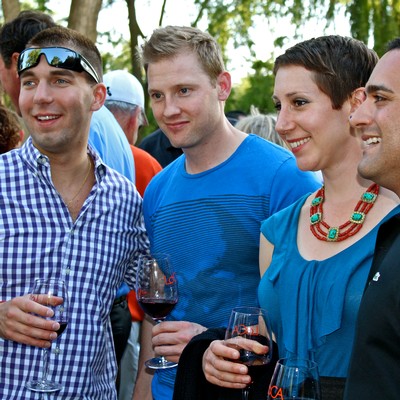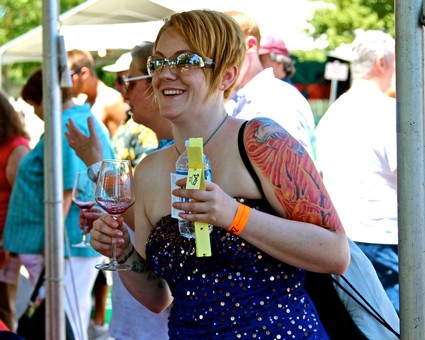Letters from Lodi
An insightful and objective look at viticulture and winemaking from the Lodi
Appellation and the growers and vintners behind these crafts. Told from the
perspective of multi-award winning wine journalist, Randy Caparoso.
How to taste wine at Lodi ZinFest
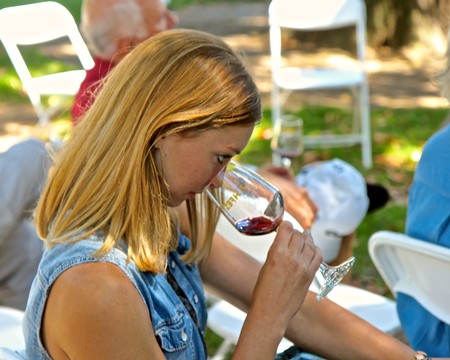
Tasting wine at ZinFest Wine School
How to taste wine (without the gobbleygook)
Ready to get into the Lodi ZinFest swing of things?
Tasting wine is not as complicated as you think. It is, in fact, just like tasting food, except it involves a liquid in a glass, and getting accustomed to a five-part process involving
• Seeing
• Swirling
• Smelling
• Sipping
• Spitting
As Yogi Berra might have said, you can see a lot by looking, and so it is just as important to look at a wine before you taste it as it is to look at a dish before you eat it. Mostly because our senses of smell and taste are most definitely connected to our visual sense. If you see a lemon, you expect to taste a fruit that is extremely tart or sour. If you see a grilled steak, you expect something meaty and drippy. Just like if you see a white wine, you expect something cool, fairly light and refreshing. Or if you see a red wine, you expect a a dryer, meaty or richly textured taste.
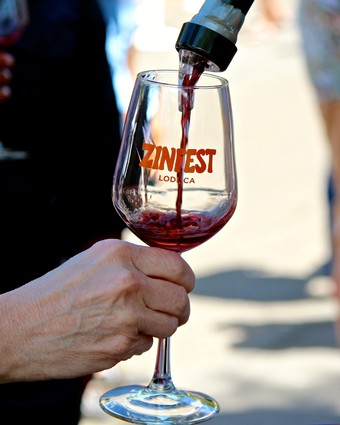
Then you begin the process of tasting, which you start by swirling wine around in your glass. Swirling wine in a glass is not an affectation. The reason you swirl a wine is to allow it fall down the sides and create the vapors that you smell and perceive as aromas. This is why good wine glasses are usually clear, tulip shaped, come with a stem, and best poured to only a third full at a time – to contain the vapors and keep you from spilling as you swirl.
Start by holding your glass by the stem (always hold wine glasses by the stem, not the bowl), and gently twirl in circular motion. If this feels awkward, you can practice by moving your glass around in a little circle as it sits on the table.
Then it’s time to smell. As you bring your nose to the rim of the glass, open your mind up to what it reminds you of. Chardonnays, for instance, are often reminiscent of apple or pineapple; often with a touch of vanilla or creaminess (the latter aromas, usually a reflection of the white oak barrels in which Chardonnay is often aged). Cabernet Sauvignons typically smell like dark fruits, such as blackcurrant and blackberry; often with a little bit of green pepper, mint or eucalyptus – all natural characteristics of the grape. Red wines made from Zinfandel grapes typically have raspberry or cherry-like aromas; often with a hint of spice (usually liked cracked black pepper, cinnamon or clove).
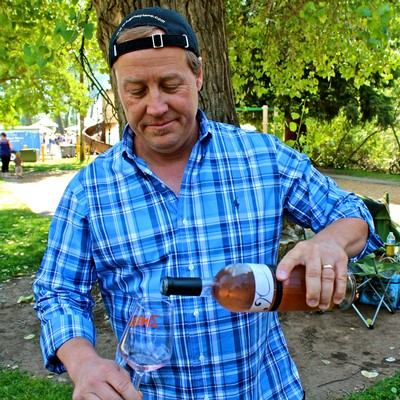
Harney Lane Winery's Kyle Lerner pouring refreshingly dry rosé at ZinFest
The idea is that if you can’t smell wine then you really can’t taste it, since flavor is related directly to smell. Think of days when you have a bad cold and your nose is congested, and almost everything you eat tastes like paper. No smell, no flavor; which goes for food, and especially for wine. That’s why you swirl before you smell your wine – the idea is to enhance the smell, and thus flavor, of every wine you taste.
Finally it’s time to sip, which for wine entails discovering how the natural elements of alcohol, acidity, and (for red wine) tannin come together with the aromas to create a pleasant (hopefully!) flavor as it sits on the tongue just before it is swallowed.
Under normal circumstances – like sitting at a table, enjoying a wine with your meal – you let the wine slide right down your throat. But when you are participating in an event like ZinFest, when you plan to taste dozens upon dozens of different wines, it is most definitely not a great idea to swallow every wine you taste.
Virtually all of us are technically intoxicated when we consume a full bottle of wine, and there are only 25.4 ounces in a bottle. Therefore, if you swallow 1 ounce each of 25 different wines, there is no way you can fully enjoy a big wine tasting event such as ZinFest. But if you practice spitting out your wine (discreetly into a cup, or onto the grass), you can fully enjoy the taste of dozens of wines – and there will be at least 200 different (mostly wonderful) wines to choose from at ZinFest!
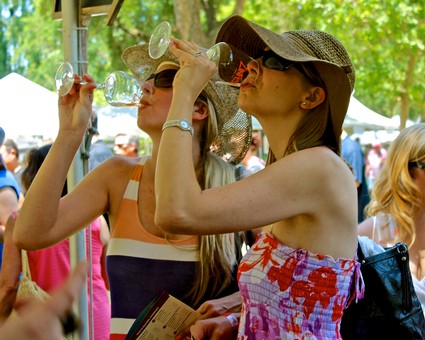
ZinFest wine tasting with style
In respect to a wine’s feel on the palate, it is alcohol content that gives a sense of “body,” which is a good word to use when describing whether a wine is light, heavy, or somewhere in-between. Sauvignon Blancs that are around 12%-13% alcohol, for instance, usually taste lighter than Chardonnays, which are typically over 14% in alcohol. Zinfandels over 15% in alcohol taste fuller in body than Zinfandels closer to 13% alcohol.
Red wines such as Cabernet Sauvignon, Merlot, Zinfandel, Syrah and Petite Sirah are almost always very full in alcohol (14% or more). Generous levels of tannin – phenolic sensations derived from the skins and seeds of grapes (since red wines are always fermented with skins and seeds) – further accentuate the feel of body. Although red wines made from grapes such as Grenache or Pinot Noir grape can be just as high in alcohol, they may very well taste lighter or softer in body simply because they are thinner skinned grapes, and thus typically lower in tannin than wines made from Cabernet Sauvignon and Merlot.
Finally, it is time to make a sober quality assessment. Did you enjoy the look, the aroma and taste of a wine, or was it just so-so? Many people can’t abide by dry wines, which they find bitter or harsh; although most people these days really don’t like wines that are even a little sweet, finding them cloying or annoying. Like most anything in life, taste in wine is, in fact, a matter of taste. And we can all have “good taste” without having exactly the same taste.
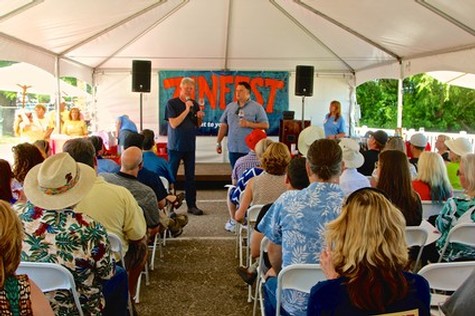
At ZinFest Wine School, m2's Layne Montgomery and Turley's Tegan Passalacqua lead tasting
If you have a democratic, or catholic, taste (in the sense of appreciating just about any wine that is well made or finely crafted), then what you probably look for more than anything is a sense of balance, or a certain harmony or smoothness, whether the wine is dry or a little sweet, light or full bodied, white or red, pink or bubbley.
And if you truly enjoy the taste of a wine? Try to remember it; or better yet, jot down a note. In big events like ZinFest, who can remember everything you taste? Half the joy of fine wine is appreciating it with our minds or intellect, as much as our senses.
Finally, all the words you need to know to talk about wine
Entire books and magazines, of course, are devoted to the description of wines, and the subject can be quite complex, since there is are a seemingly endless number of good wines produced in the world these days.
ZinFest wine lovers
In the everyday setting, however, you need only be able to communicate the taste of wine to guests in basically six ways:
Color or appearance – is it still or sparkling… pink, white or red… deep, almost purplish red… or a lighter, brick toned red?
Aroma (i.e. the wine’s “flavor” once it hits the palate) – what does it remind you of… a certain fruit, a spice, flower, or even mineral?
Dryness/sweetness — some degree of sweetness, or none at all?
Body or weight — is it light, full, or just “medium”?
Acidity (particularly for whites and sparklers) – is it zesty or tart… or the opposite, soft and round?
Tannin level (particularly for reds) – big or hard… light and soft… somewhere in between?
And that’s it; all the words you need. Enjoy your Lodi ZinFest experience!
ZinFest wine enthusiast
